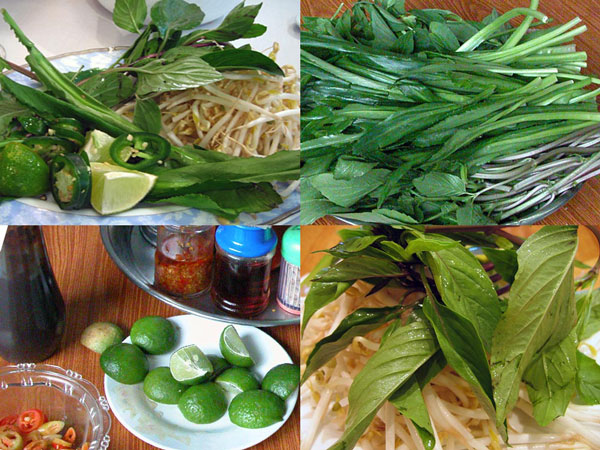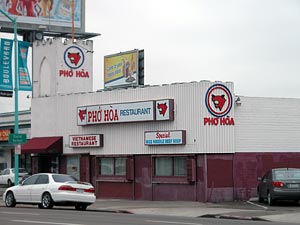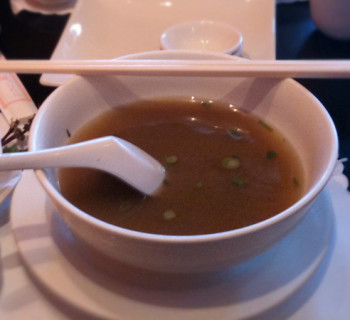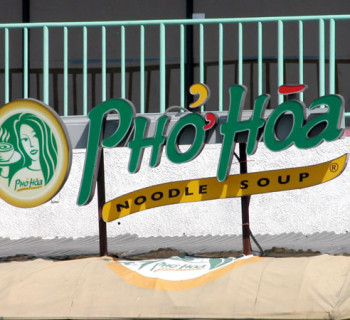A good bowl of Vietnamese Pho can always stand on its own merit. Pho itself is so good that for many, both the restaurant and home cooked varieties, there is no need for all the elaborate condiments and garnishes you'd get at a pho restaurant. However, Vietnamese dishes are meals typically served with lots of greens, herbs, vegetables and various other accompaniments such as dipping sauces, hot and spicy pastes, and flavor enhancements such as a squeeze of lime or lemon. Well Pho is no exception.
 Garnishes for Pho is so important to the total pho experience that our rating system treats garnishes freshness and quantity as separate point earners. Here's LovingPho.com's rating system based on points on scale from 1 to 5, with 5 being best:
Garnishes for Pho is so important to the total pho experience that our rating system treats garnishes freshness and quantity as separate point earners. Here's LovingPho.com's rating system based on points on scale from 1 to 5, with 5 being best:
- Pho noodle: scale 1-5.
- Soup stock: scale 1-5.
- Meats: scale 1-5.
- Garnishes*: freshness, scale 1-5.
- Garnishes: extra points for fresh ngo gai (scale 1-5). The fresher and more in quantity, the higher the points!
- Price: scale -5 to +5 based on baseline of $5-$6 per bowl (California price) being 0 point. Lower than baseline price gets extra points, while higher prices can earn negative points!
- Extra points: scale 1-5 for general ambience of the location, including clean dining area, airy and light ambience, good reliable service, totally authentic Vietnamese ambience, etc.
* No points for expected garnishes of sprouts, Thai basil, lime and chiles.
So as you can see garnish can really take the total points up a notch or down a level. Garnishes have a strong impact on the total experience of enjoying a bowl of pho, and we're serious about it. Here's what I mean:
- Expected garnishes. We consider bean sprouts, basil, lime or lemon, and freshly sliced chiles to be must have items, and only rate them on levels of freshness from 1 to 5. Of note is the chiles or peppers. Most U.S. pho places serve sliced Mexican jalapeño in place of the smaller hot pepper varieties in Vietnam, usually served whole (unsliced). This in our view is an acceptable arrangement, and places with authentic offerings will get more points.
- We consider ngo gai (culantro) important enough to the total pho eating experience that it has its own rating. Many restaurants skipped ngo gai altogether and will get low or no points. In our view there is no excuse for not having it, and those offering lots of ngo gai will get points galore.
Now after all of this, there is an exception. When it comes to Phở Bắc, the northern style (Bắc means north) that came south with Northern refugees in the 1940's, purity is heaven. If you're having Pho Bac, then you're not supposed to need any garnish. It's good as is. As Andrea Nguyen wrote in her Viet World Kitchen article: "Even today, what many Americans identify as the requisite pho garnish plate is hard to find in Hanoi. For purists like my northern-born mom, only "pho bac'' (northern pho) will do." For Pho Bac, our rating system will have to be adjusted and applied properly.
If you're going to garnish your pho, only culantro, basil, sprouts, with a touch of lemon/lime will do. I'm sure the combination of taste was not developed overnight, but I'm glad someone did it, and the rest of us went for it. In the end, from the texture of the noodle and meat pieces, to the taste and heat of the soup broth, to the fresh green garnishes, with a touch of lime and heat of chile pepper, and finally the sweet and spicy touch of hoisin sauce and red hot sauce, everything just comes together nicely.
So what do you prefer when it comes to garnishing your pho? Chances are unless the restaurant you're in identifies itself as having Pho Bac or offering Pho Bac on the menu specifically, each and every pho place you eat at will be the regular southern variety with garnishes. Share your pho garnish experience with us.




Very informative there Cuongis. Where did you get those shots of all the fresh garnishes? It’s a Pho garnish medley you’ve created.
I’m not sure I could eat Pho without all the good stuff we put in like bean sprouts, lime, basil, hoison, sriracha. Although some Pho is that good where it can stand alone without the flare of the garnish.
Thanks Tim. All the shots are of freshest garnish that I took when having pho at different places. Close-up look real good don’t they?
The large mound of culantro ngo gai at upper right was actually from Pho Hoa Pasteur in Saigon. The tray that was holding it must have been about 10-12 inches in diameter and 2 inches deep! Not like the small saucer/plate we get around here. Actually over there you can count on getting huge portions of garnish. It’s expected to be provided.
Re: Pho Bac. I think for me, pho Bac is a little tastier in the broth, as it has more of the spice star anise and as a result a little more pungent in both taste and smell. But it’s all about knowing you’re eating the original, much like appreciating real Italian pizza you get in Italy versus the American varieties with tons of toppings.
I agree with you. Sometime you hit a place with pho that is so good, who needs all the extra stuff.
I love this site! Thanks for creating it, and making Pho info available to the general audience. I had a question about Northern Pho, which you say doesn’t need garnishes. Why not? What is special/different about the broth?
I also wondered, having tasted a restaurant Pho here in upstate NY, how cinnamon-y and anise-y is the broth supposed to taste, compared to the savory flavors. Can you comment on the flavor balance in an authentic broth? I am particularly interested in vegetarian Pho, which I realize from your site is not actually authentic Pho.
Hi Rachel: Thanks for the kind words! The key to understand Pho Bac (northern pho) is in the chronology of how pho was developed and propagated. As noted in my article “The History and Evolution of Pho: A Hundred Years’ Journey”, pho is believed to have been started from the North of Vietnam. It’s more about how it was started and what was available as ingredients at the time, rather than if Northern Pho actually “needs” garnishes. It was started without much garnishes, and Northern Vietnamese like it just fine this way. Nowadays, with both types intermingling in many pho shops, it’s up to the customers to add or not to add basil, culantro, sprouts, etc.
With respect to what many, me included, consider as “authentic” pho, it is really subjective at best. From my other post titled On Viet People’s Expectations, Standards, and Ideals for Pho vs. Non-Viet, I believe it boils down to 3 factors for a non-Viet to understand what good pho is: 1) try multiple times and places to understand the consistencies and inconsistencies, 2) get opinions from Viet friends, or 3) go where the Viet crowds gather.
In my opinion, the only reason vegan pho is not considered authentic is because, like any other vegan dishes, it is created to serve a particular need or niche, based on an already established or available dish, and not necessarily as an original. Hope this helps.